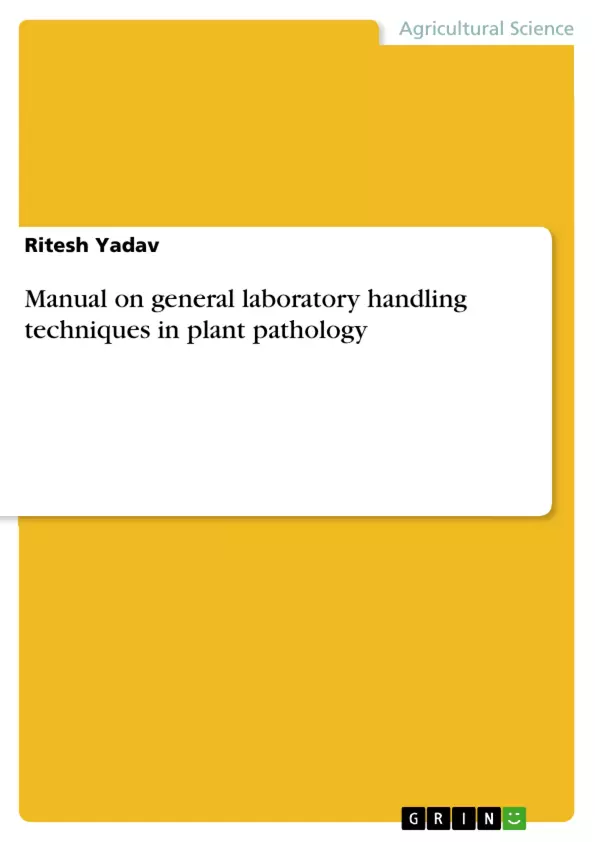This book is a manual on general laboratory handling techniques in plant pathology. It will present different conditions that are essential for those who are interested in working in the field of plant pathology in a laboratory. The analysis in this book focuses on various circumstances like general requirements, laboratory equipments, sterilization techniques, the isolation of bacteria etc.
When designing a laboratory there are many aspects to consider. It is important that work should be carried out in a logical order and, that particular parts of the diagnostic protocol are separated from one another. General plant protection laboratory may have the following different rooms and chamber as appropriate. The preparation room is used for preparing media, including sterilizing items in the autoclave, sterilizing petri dishes in an oven, washing glassware and storing glassware, chemicals and other basic items.
This room should have an exhaust fan to remove hot air produced by the autoclave and the oven. The clean room is used for isolating fungi and bacteria from cleaned subsamples of diseased plant tissue into pure cultures. It is also used for growing cultures under clean conditions. The microscopes are located in this room for examining cultures and fungal structures. This room should be air-conditioned, if possible, to protect equipment and cultures. It should also be kept free from dust and insects. If, do not have an airtight clean room or humidity will be too high and fungus (mould) will develop on walls and equipment. A dehumidifier is useful in this room. No soil is allowed in the clean room as soil is a source of fungus-eating mites that can contaminate cultures.
Inhaltsverzeichnis (Table of Contents)
- GENERAL REQUIREMENTS AND FACILITIES FOR A PLANT QUARANTINE LABORATORY
- Infrastructure & Utilities
- Human resources
- Location of the laboratory
- Laboratory layout
- KNOWING LABORATORY EQUIPMENTS, APPLIANCES, GLASSWARE AND CHEMICALS WITH THEIR SAFE HANDLING TECHNIQUES
- A LABORATORY EQUIPMENTS
- Analytical Balances
- Heating Apparatus
- Distillation Plant
- Hot Plates
- Autoclave
- Heating Mantles
- Berlese Funnel
- Cooling Apparatus
- Desiccators
- Magnifying Instruments
- Rotary evaporator
- Suction pump
- Centrifuge
- Microtome
- Vernier calipers
- Camera
- Tally counter
- Hygrometer
- Maximum and Minimum Thermometer
- B.GLASSWARE:
- C. CHEMICALS
- Chemicals Used For Insect Killing
- Chemicals Used As Preservatives
- Chemicals Used As Disinfectants
- Chemicals For Slide Preparation
- Chemicals For Pesticide Residue Extraction
- D. MISCELLANEOUS E QUIPMENTS:
- KILLING, PRESERVATION AND TRANSPORTATION TECHNIQUES FOR INSECT PESTS
- Killing of insect
- Killing Methods
- Relaxing
- Cleaning specimens
- Insect labeling
- Preservation
- 'U\SUHVHUYDWLRQRILQVHFWV
- :HWSUHVHUYDWLRQ
- Transportation of insect pest specimens
- Procedures for packing dried pinned specimen:
- Procedures for packing liquid preserved specimen:
- Culture of insects
- PREPARATION OF CULTURE MEDIA FOR FUNGI AND BACTERIA
- GENERAL PROCEDURE FOR THE PREPARATION OF BASIC MEDIUM
- A) Preparation of Potato Dextrose Agar Medium:
- B. Preparation of Nutrient Agar Medium:
- STERILIZATIION TECHNIQUES IN LABORATORY
- Physical methods of sterilization :
- +HDW
- 0RLV
- 5DGLDWLRQ
- )LOWUDWLRQ
- Sterilization by Chemical Methods:
- ISOLATION OF PLANT PATHOGENIC FUNGI FROM DISEASED PLANT MATERIAL
- ISOLATION OF PHYTO-PATHOGENIC BACTERIA FROM DISEASED PLANTS
- ISOLATION OR EXTRACTION METHODS FOR NEMATODES FROM PLANT AND SOIL SAMPLE
- EXTRACTION FROM SOIL SAMPLE
- Baermann funnel method
- Extraction of nematodes from the plant sample
- MAINTENANCE AND STORAGE OF VIRUS ISOLATES
- As dried powder
- In liquid nitrogen
- By lyophilization
- PRESERVATION OF DISEASE SAMPLES
- a. Collection and dry preservation of plant disease specimen
- b. Wet preservation of diseased specimens
- PURE CULTURE MAINTENANCE OF PLANT PATHOGENS
- (i) Streaking technique
- (ii) Spore suspension dilution technique
- (iii) Single – hyphal tip culture
Zielsetzung und Themenschwerpunkte (Objectives and Key Themes)
This manual aims to provide a comprehensive guide to general laboratory handling techniques in plant pathology, focusing on the practical aspects of quarantine laboratory procedures. The manual is designed to assist plant pathologists, technicians, and students in developing the skills and knowledge necessary for successful disease diagnosis and management.
- Laboratory Infrastructure and Safety
- Plant Pathogen Isolation and Identification
- Insect Pest Handling and Preservation
- Culture Media Preparation and Sterilization
- Virus Maintenance and Storage
Zusammenfassung der Kapitel (Chapter Summaries)
Chapter 1 details the essential requirements and facilities for a plant quarantine laboratory, including infrastructure, human resources, and laboratory layout. Chapter 2 provides a comprehensive guide to various laboratory equipment, appliances, glassware, and chemicals used in plant pathology, along with their safe handling techniques. Chapter 3 focuses on the techniques for killing, preserving, and transporting insect pests, including methods for both dry and wet preservation. Chapter 4 outlines the methods for preparing culture media for fungi and bacteria, including detailed procedures for preparing Potato Dextrose Agar (PDA) and Nutrient Agar (NA) media. Chapter 5 covers the essential sterilization techniques used in plant pathology laboratories, encompassing both physical and chemical methods. Chapter 6 presents the procedure for isolating plant pathogenic fungi from diseased plant material. Chapter 7 describes the methods for isolating phyto-pathogenic bacteria from diseased plant tissue. Chapter 8 provides a detailed explanation of nematode extraction methods from both plant and soil samples, including the Baermann funnel technique. Chapter 9 explains the methods for maintaining and storing virus isolates, covering techniques like drying, liquid nitrogen storage, and lyophilization.
Schlüsselwörter (Keywords)
Plant pathology, quarantine laboratory, laboratory equipment, glassware, chemicals, insect pests, culture media, sterilization, fungal pathogens, bacterial pathogens, nematodes, virus isolates, preservation, disease diagnosis, disease management.
- Citation du texte
- Ritesh Yadav (Auteur), 2019, Manual on general laboratory handling techniques in plant pathology, Munich, GRIN Verlag, https://www.grin.com/document/457722



